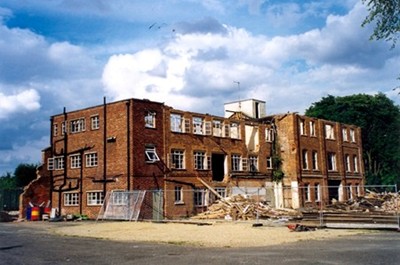THE END OF THE WORKHOUSE
- once the last refuge for the poor and destitute
by REX NEEDLE

|
The story of our heritage
can be traced through the buildings that have survived the
centuries although much more can be learned by studying the
history of those we have lost. Wealth and poverty are major influences in our society but the rich can take care of themselves and so it is the poor who become the victims. The 71 listed buildings in Bourne have already produced a mine of information about our past but none provide such a graphic record as one which was demolished sixteen years ago for it was here that the worst conditions from the Victorian age were manifest yet this was done in the name of welfare and of charity for the most deprived members of our society, those who had not only lost everything but had also abandoned hope. The conditions that prevailed have been immortalised by Charles Dickens in his novel Oliver Twist, written against the background of the Poor Law Amendment Act of 1834 which ended supplemental dole for the impoverished and forced husbands, wives and children into separate institutions in the name of utilitarian efficiency. Until then, each parish was responsible for providing relief to deserving cases but the burden on the rates was becoming heavy and the relatively easy terms on which men without an adequate wage could get financial help from public funds was being regularly abused. The government therefore decided to impose a more rigid procedure and the new legislation decreed that able-bodied men who could find no work had no option but to enter the workhouse, taking their families with them although in some cases, children were boarded out with foster parents. This was the main principle of the act which also required parishes to be grouped together as unions with a workhouse for each. As a result, Bourne Poor Law Union was formed in 1835 and a Board of Guardians appointed to supervise the system, a total of 44 in number representing 37 constituent parishes, and they lost no time in establishing the new regime which became operative by the end of the following year. The town already had a workhouse in North Street near the junction with Burghley Street which was then called Workhouse Road, but this was too small to cater for the new legislation and so in 1836 a new building was erected in what is now St Peter's Road at a cost of £5,350 [over £½ million at today’s values] with room for 300 paupers but was rarely full because admission was discouraged by the guardians who enforced a strict regime in the hope of persuading the poor to seek employment rather than live in such forbidding and uncongenial surroundings. An example of the conditions that prevailed can be found in the workhouse accounts which indicate that a mere 5p per head per day was spent on the inmates and that included food and clothing. Outdoor relief was also provided for the poor in their homes, there being a great resistance to entering the workhouse and some who could not face the shame of admission even committed suicide. Productive work was not encouraged, rules were strict, meals basic and a policy of economy left no room for luxuries. Christmas brought a welcome but temporary relief when food and small gifts from wealthy citizens enabled inmates celebrate the festive season for a few hours and in 1895, the Bourne guardians set a precedent by allowing the old men in the workhouse an ounce of tobacco a week, a rare act of generosity which became known throughout the country as “the pauper’s pipe”. Such a restrictive regime took its toll with the result that the death rate was high and the many grassy spaces to be found around the town cemetery in South Road serve as a reminder of those unfortunate men, women and children who died destitute and were given a pauper’s funeral before being buried in unmarked graves. In 1863, the name of the institution was changed from the Bourne Union Workhouse to Waterloo Square in an attempt to remove the stigma attached to the original address, especially among unmarried mothers who often gave birth there. But the social disgrace of the workhouse system remained well into the 20th century and today it is remembered in folklore and literature as a place synonymous with the hunger, poverty and deprivation experienced by the distressed and downtrodden in 19th century England. Improvements in social conditions brought about a gradual decline in the workhouse system and by 1905, other charities were springing up to provide relief for the poor. Then in 1908, a Royal Commission tried to end the humiliation of poverty with the establishment of a Public Assistance Authority while the creation of new social services in the years following the end of the Great War in 1918 meant that the days of institutional assistance were over. In 1930, the workhouse premises were converted for use as a mental hospital known as the Bourne Public Assistance Institution, also referred to as Wellhead House, subsequently becoming St Peter's Hospital for mentally handicapped women and children, a facility which was eventually run down and patients moved out under the government's policy of care in the community and by 1992 the place was empty. The buildings remained so until 1997 when the site was bought by the printing firm Warners Midlands plc for an expansion of their business interests and in the summer of 2001, the bulldozers moved in to demolish the complex, a stark reminder of this grim chapter from our social history. Today, Bourne has an expanding and changing population and the majority know little of this bleak period from our past but the images that survive remain a potent reminder of the way it was. |